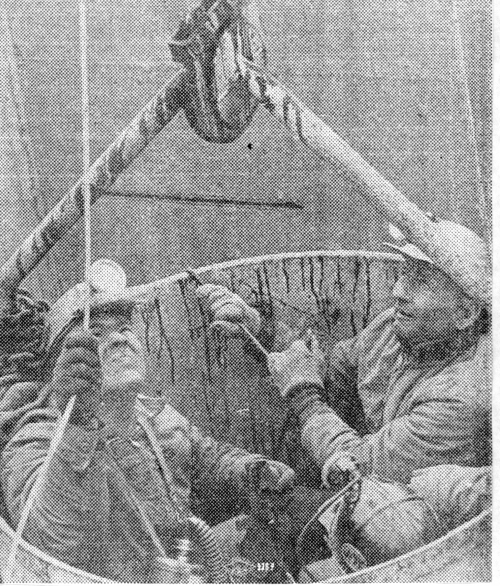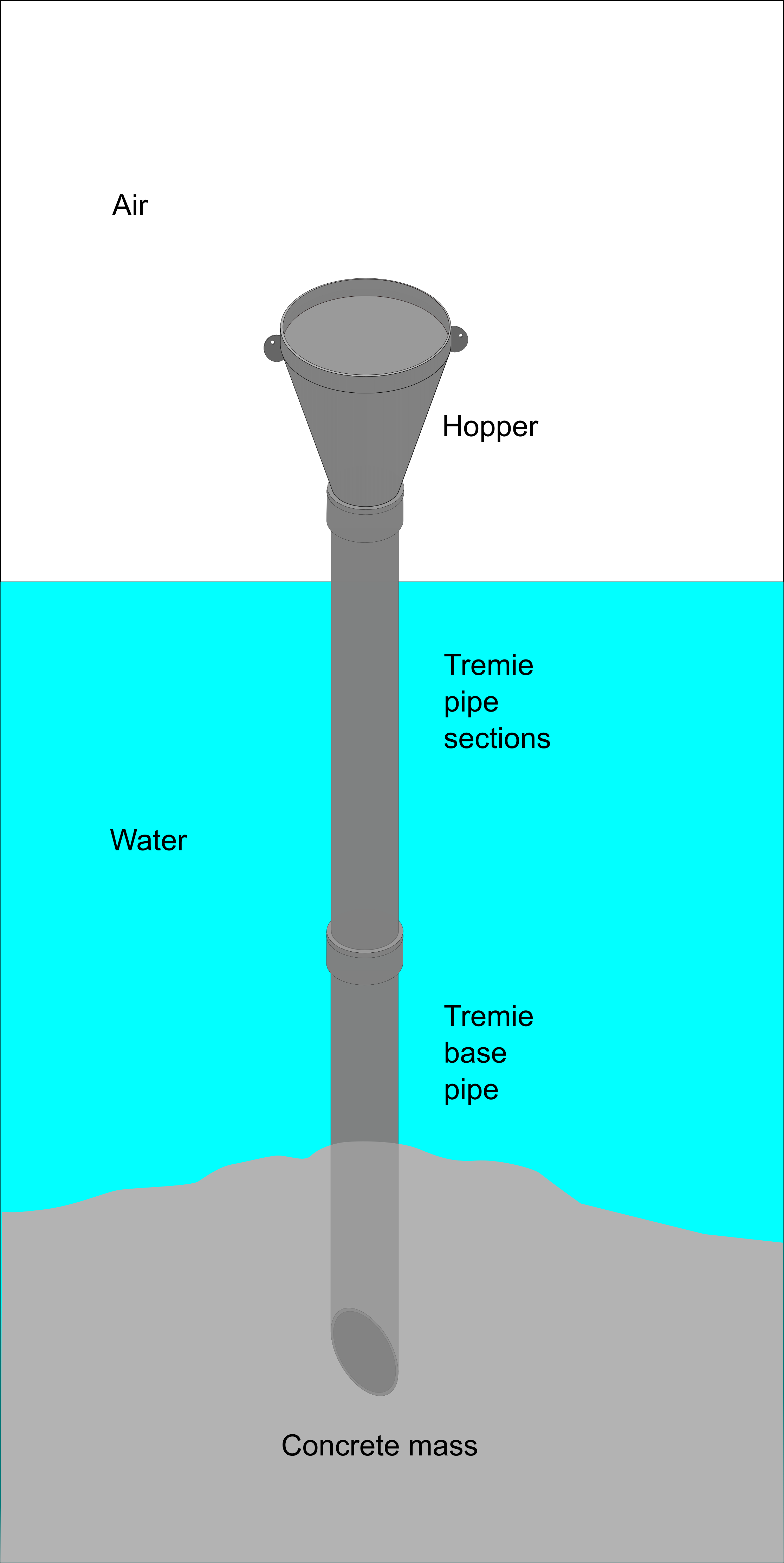|
Caisson (engineering)
In geotechnical engineering, a caisson (; borrowed , , an augmentative of ) is a watertight retaining structure. It is used, for example, to work on the foundation (architecture), foundations of a bridge pier (architecture), pier, for the construction of a concrete dam, or for the repair of ships. Caissons are constructed in such a way that the water can be pumped out, keeping the work environment dry. When piers are being built using an open caisson, and it is not practical to reach suitable soil, Deep foundation, friction pilings may be driven to form a suitable sub-foundation. These piles are connected by a foundation pad upon which the column pier is erected. Caisson engineering has been used since at least the 19th century, with three prominent examples being the Royal Albert Bridge (completed in 1859), the Eads Bridge (completed in 1874), and the Brooklyn Bridge (completed in 1883). Types To install a caisson in place, it is brought down through soft mud until a suitable ... [...More Info...] [...Related Items...] OR: [Wikipedia] [Google] [Baidu] |
Caisson Schematic
Caisson (French for "box") may refer to: * Caisson (engineering), a sealed underwater structure * Caisson (vehicle), a two-wheeled cart for carrying ammunition, also used in certain state and military funerals * Caisson (Asian architecture), a spider web ceiling * Caisson (lock gate), a gate for a dock or lock, constructed as a floating caisson * Caisson (pen name), of Edward Sperling * Caisson (western architecture), a type of coffer * Caisson disease, or decompression sickness * Caisson lock, a type of canal lock See also * Caisson foundation (other), Caisson foundation * Kazon, a fictional alien race in ''Star Trek'' * Khe Sanh {{disambiguation ... [...More Info...] [...Related Items...] OR: [Wikipedia] [Google] [Baidu] |
Bucket (machine Part)
A bucket (also called a scoop to qualify shallower designs of tools) is a specialized container attached to a machine, as compared to a bucket adapted for manual use by a human being. It is a bulk material handling component. The bucket has an inner volume as compared to other types of machine attachments like blades or shovels. The bucket could be attached to the lifting hook of a crane, at the end of the arm of an excavating machine, to the wires of a dragline excavator, to the arms of a power shovel or a tractor equipped with a backhoe loader or to a loader, or to a dredge. The name "bucket" may have been coined from buckets used in water wheels, or used in water turbines or in similar-looking devices. Purposes Buckets in mechanical engineering can have a distinct quality from the traditional bucket (pail) whose purpose is to contain things. Larger versions of this type of bucket equip bucket trucks to contain human beings, buckets in water-hauling systems in mines or, f ... [...More Info...] [...Related Items...] OR: [Wikipedia] [Google] [Baidu] |
Barotrauma
Barotrauma is physical damage to body tissues caused by a difference in pressure between a gas space inside, or in contact with, the body and the surrounding gas or liquid. The initial damage is usually due to over-stretching the tissues in tension or shear, either directly by an expansion of the gas in the closed space or by pressure difference hydrostatically transmitted through the tissue. Tissue rupture may be complicated by the introduction of gas into the local tissue or circulation through the initial trauma site, which can cause blockage of circulation at distant sites or interfere with the normal function of an organ by its presence. The term is usually applied when the gas volume involved already exists prior to decompression. Barotrauma can occur during both compression and decompression events. Barotrauma generally manifests as sinus or middle ear effects, lung overpressure injuries and injuries resulting from external squeezes. Decompression sickness is indir ... [...More Info...] [...Related Items...] OR: [Wikipedia] [Google] [Baidu] |
Decompression Sickness
Decompression sickness (DCS; also called divers' disease, the bends, aerobullosis, and caisson disease) is a medical condition caused by dissolved gases emerging from Solution (chemistry), solution as bubbles inside the body tissues during Decompression (diving), decompression. DCS most commonly occurs during or soon after a decompression ascent from underwater diving, but can also result from other causes of depressurisation, such as emerging from a Caisson (engineering), caisson, decompression from Saturation diving, saturation, flying in an Cabin pressurization, unpressurised aircraft at high altitude, and extravehicular activity from spacecraft. DCS and Air embolism, arterial gas embolism are collectively referred to as decompression illness. Since bubbles can form in or migrate to any part of the body, DCS can produce many symptoms, and its effects may vary from joint pain and rashes to paralysis and death. DCS often causes air bubbles to settle in major joints like knee ... [...More Info...] [...Related Items...] OR: [Wikipedia] [Google] [Baidu] |
Decompression (physics)
In mechanics, compression is the application of balanced inward ("pushing") forces to different points on a material or Structural system, structure, that is, forces with no Net force, net sum or torque directed so as to reduce its size in one or more directions.Ferdinand Pierre Beer, Elwood Russell Johnston, John T. DeWolf (1992), "Mechanics of Materials". (Book) McGraw-Hill Professional, It is contrasted with tension (physics), tension or traction, the application of balanced outward ("pulling") forces; and with shear stress, shearing forces, directed so as to displace layers of the material parallel to each other. The compressive strength of materials and structures is an important engineering consideration. In uniaxial compression, the forces are directed along one direction only, so that they act towards decreasing the object's length along that direction. The compressive forces may also be applied in multiple directions; for example inwards along the edges of a plate or ... [...More Info...] [...Related Items...] OR: [Wikipedia] [Google] [Baidu] |
Work In Compressed Air
Work in compressed air, compressed air work or hyperbaric work is occupational activity in an enclosed atmosphere at a controlled ambient pressure significantly higher than the adjacent normal atmospheric pressure. There are many parallels with underwater diving, and a few significant differences. Applications Compressed air work is mostly used in civil engineering projects where a raised ambient pressure is used to counteract ingress of groundwater from the surrounding soil or rock by balancing the hydrostatic pressure of the water with an applied air pressure inside an enclosed and sealed working area, such as a caisson, shaft, or tunnel. Classes Traditionally, compressed air work was limited to maximum ambient pressures of between , but experience with offshore saturation diving shows that higher pressures can be managed at acceptable risk using the techniques developed in that industry, including saturation exposures and the use of breathing gases other than air. Compressed ... [...More Info...] [...Related Items...] OR: [Wikipedia] [Google] [Baidu] |
Clamshell Bucket
A bucket (also called a scoop to qualify shallower designs of tools) is a specialized container attached to a machine, as compared to a bucket adapted for manual use by a human being. It is a bulk material handling component. The bucket has an inner volume as compared to other types of machine attachments like blades or shovels. The bucket could be attached to the lifting hook of a Crane (machine), crane, at the end of the arm of an excavator, excavating machine, to the wires of a dragline excavator, to the arms of a power shovel or a tractor equipped with a backhoe loader or to a Bucket loader, loader, or to a Dredging, dredge. The name "bucket" may have been coined from buckets used in water wheels, or used in water turbines or in similar-looking devices. Purposes Buckets in mechanical engineering can have a distinct quality from the traditional bucket (pail) whose purpose is to contain things. Larger versions of this type of bucket equip bucket trucks to contain human beings, ... [...More Info...] [...Related Items...] OR: [Wikipedia] [Google] [Baidu] |
Crane (machine)
A crane is a machine used to move materials both vertically and horizontally, utilizing a system of a boom, hoist, wire ropes or chains, and sheaves for lifting and relocating heavy objects within the swing of its boom. The device uses one or more simple machines, such as the lever and pulley, to create mechanical advantage to do its work. Cranes are commonly employed in transportation for the loading and unloading of freight, in construction for the movement of materials, and in manufacturing for the assembling of heavy equipment. The first known crane machine was the shaduf, a water-lifting device that was invented in ancient Mesopotamia (modern Iraq) and then appeared in ancient Egyptian technology. Construction cranes later appeared in ancient Greece, where they were powered by men or animals (such as donkeys), and used for the construction of buildings. Larger cranes were later developed in the Roman Empire, employing the use of human treadwheels, permitting the ... [...More Info...] [...Related Items...] OR: [Wikipedia] [Google] [Baidu] |
Sandhogs
Sandhog is the slang term given to urban miners and construction workers who work underground on a variety of excavation projects in New York City, and later other cities. Generally these projects involve tunneling, caisson excavation, road building, or some other type of underground construction or mining projects. The miners work with a variety of tools including using tunnel boring machines and explosives to remove material for the project they are building. The term sandhog is an American colloquialism. Starting with their first job in 1872, the Brooklyn Bridge, the "hogs" have built a large part of the New York City infrastructure including the subway tunnels and sewers, Water Tunnels No. 1 and No. 2 as well as the currently under construction Water Tunnel No. 3, the Lincoln, Holland, Queens-Midtown, and Brooklyn-Battery tunnels. In addition, they worked on the foundations for most of the bridges and many of the skyscrapers in the city. Traditionally, these workers hav ... [...More Info...] [...Related Items...] OR: [Wikipedia] [Google] [Baidu] |
Airlock
An airlock is a room or compartment which permits passage between environments of differing atmospheric pressure or composition, while minimizing the changing of pressure or composition between the differing environments. An airlock consists of a chamber with two Hermetic seal, airtight doors or openings, usually arranged in series, which do not open simultaneously. Airlocks can be small-scale mechanisms, such as Fermentation lock, those used in fermenting, or larger mechanisms, which often take the form of an antechamber. An airlock may also be used underwater to allow passage between the air environment in a pressure vessel, such as a submarine, and the water environment outside. In such cases the airlock can contain either Atmosphere of Earth, air or water. This is called a floodable airlock or underwater airlock, and is used to prevent water from entering a submersible vessel or underwater habitat. Operation The procedure of entering an airlock from the external or am ... [...More Info...] [...Related Items...] OR: [Wikipedia] [Google] [Baidu] |
Tremie
A tremie is a watertight pipe, usually of about 250 mm inside diameter (150 to 300 mm), with a conical hopper at its upper end above the water level. It may have a loose plug or a valve at the bottom end. A tremie is usually used to pour concrete underwater in a way that avoids washout of cement from the mix due to turbulent water contact with the concrete while it is flowing. This produces a more reliable strength of the product. Common applications include: * Caissons, which are the foundations of bridges, among other things, that span bodies of water. * Pilings. * Monitoring wells. Builders use tremie methods for materials other than concrete, and for industries other than construction. For example, bentonite slurries for monitoring wells are often emplaced via tremie pipe. Function The tremie concrete placement method uses a vertical or nearly vertical pipe, through which concrete is placed by gravity feed below water level. The lower end of the pipe is kept immersed in ... [...More Info...] [...Related Items...] OR: [Wikipedia] [Google] [Baidu] |





